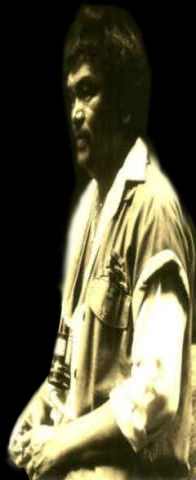
THE ASEAN FILM DIRECTOR
Celso Ad Castillo is proud of his bloodline. It is after all, as Filipino with all its centuries of uninterrupted cultural accretion, that he has come to be what he is today.
A compleat artist, auteur, painter, musician, fictionist and a lover of things beautiful (in the panoramic sense).
But in this part of our world in no way dep- rived of noble, if sentimental, nationalism, nothing is, for Celso, as such of being a Filipino as being an Asian or, more par- ticularly, an Asean (put it this way, a short flashback to history twenty or so years ago).
The almost sacrosanct Borobudor, the Burmese pagodas and Buddhist temples, our Batik-attired women, the Moro vintas, those wizened cigar-chomping Ilocano elders in Northern Philippines, the alluring Filipinas with their enticing enigmatic smiles – they all run deep in Celso's psyche as if embedded since time immemorial, but surfacing almost at a flicker like a gayzer in a wild spurt, when the subconscious makes a paean to it, as Celso so often does in his films.
For how can one ever try to desecrate the boundaries of genius really, if such an effort, if successful, would stunt, rather than nurture, its original power ? Federico Fellini is as much to Italian and Truffaut to French as they are to Filipinos or Malaysians or Japanese or Singaporeans. And so are Antonioni or Welles or Eisenstein. We are all fiduciaries of a great heritage from where everybody can drawn upon.
This veritable spiritual co-ownership ostensibly has enriched us all, Asians or Asean. It is no mark of a monarchical hauteur to say, for instance, that the films of Celso Ad Castillo, once dubbed as the Messiah of Filipino movies, are contemporaneous in their being a classic. If all these seem contradictory, Celso can easily point to his filmography to prove that there has always been, and will always be, fire in his filmmaker's eyes.
His Burlesk Queen and Pagputi ng Uwak, Pag-itim ng Tagak, for one, are now a classic, conscience-searing sociological film tractatus on structutal violence and institutional injustice that probed into the hearts of little people amidst a third world setting as encapsulated in the microscopic life of a poverty-stricken, young woman. It's Rossellini, you would say ? Think again.
Pagputi ng Uwak, Pag-itim ng Tagak was sent to Sao Paolo, Brazil for the Latin American Film Festival and represented the Philippines at the Asean Film Conference in 1981.
Ang Alamat ni Julian Makabayan was sent to the World Film Festival held in Canada in 1980 and was also chosen as the Philippines' entry to the Unesco Film Conference in Paris, France in the same year.
Virgin People was the box-office top grosser at the 1983 Manila International Film Festival, beating all local and foreign entries with earnings of P16M in 9 days, a record unsurpassed until now.
Nympha was the second filipino film that qualified for competition at the Venice Film Festival in 1972 after Manuel Conde's Genghis Khan, and the last so far.
Isla is the first Filipino movie that has an inter-
national appeal so like a European movie, through
which the distinguished Australian film director
Peter Weir (Green Card, Witness, Goodwill Hunting)
and Frank Yablan, Executive Producer of Empire
Film International based in Hollywood and London,
got to know of Castillo. Isla also revolutionized
the moral values of the Filipinos so that for the first
time, sex was being discussed at home without malice.
BACK TO PROFILE